Learn About Georges Seurat in Art History, View His Art and Famous Paintings
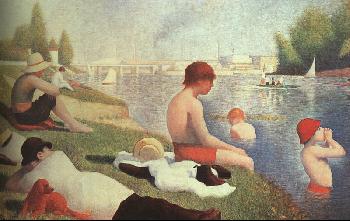
"Bathing at Asniers”, Georges Seurat, 1883-84
Georges Seurat,1859-1891, one of France’s famous artists in art history developed a new method of painting to bring solidity to Impressionism. His goal paralleled a statement by Paul Cezanne stating similarly the same thing. Seurat's method in his famous paintings, one of bringing solidity and stability to Impressionist art was a scientific mathematical theory applying small dots of paint on canvas related to each other. Then he relyied on the human eye to mix and blend them together.
Seurat differs from Impressionism's artists in that the impressionists painted many shades of one color occasionally juxtaposing other colors to be mixed optically by the eye. Georges Seurat measured the exact proportions of color within an object. He then applied that color to canvas in a scientific exactness achieving the color he wanted when optically mixed.
Seurat attempted to solidify objects and define the linear boundaries of Impressionism with his scientific method color. His color was systematically applied where Impressionist color was applied more ambiguously.
Emotion in Seurat’s artwork is expressed in color relationships and linear contours, not in figural movements, facial expression, or paint application. Happiness, are lines with an upward movement, and warm colors express cheerfulness theoretically. In Seurat's most famous work, "A Sunday Afternoon on the Island of La Grande Jatte"

Depth perception into Georges Seurat's compositions is not created by atmospheric perspective, or three-dimensional perspective. It is created by figure size and form relationship. In an unusual method of spatial and depth recession, Seurat's art causes the viewers eye in “La Grande Jatte”, to leap right over the shadow figured foreground and right into the depth of the painting, attracted by the brightness of the middle ground landscape. Drawing the eye further into the depth of background is the bold,
bright, distant, horizontal shoreline.
The spatial recession in "La Grande Jatte" is similar to that of Piero Della Francesca's "Flagellation of Christ" in the 1450's. On the right side of Piero's painting, in the close foreground, are monumental figures that set a spatial relationship in comparison with the smaller figures of the Christ grouping far to the rear. This very elemental compositional relationship to achieve depth in an artwork appears to have been an influence on Seurat.
Paul Cezanne did not use atmospheric effects or shadows to delineate depth in his paintings. Instead he used color valued patches or swatches of applied color to represent recession into space. In somewhat the same manner Georges Seurat too used a patterned composition of unarticulated form relationships to create depth, believing three-dimensional space was a function of color.
Many of Seurat's figures are in profile and he repeats contours throughout of his canvases for continuity. His stated intention was to paint contemporary people involved in functions of everyday life. Figure movement is static as if appearing on a frieze, organized by color harmonies. The direction of the color harmonies were in accordance with lines and the movement of those lines.
One of Georges Seurat’s last famous paintings, in art history “The Circus” was painted in 1891. If “La Grande Jatte” legitimized Seurat’s scientific theories, “The Circus” showed weaknesses in the theory that art can be reduced to scientific theories. Where inspired art goes beyond technical means of application, Seurat’s scientific system stays at the technical level. Other famous artists of Impressionism are Edgar Degas and Paul Gauguin.
Click on the graphics below to increase graphic sizes. At the same you time can also view an opportunity to purchase a poster or painting reproduction.
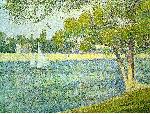
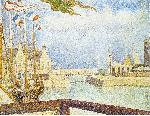
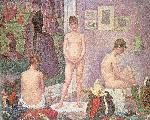
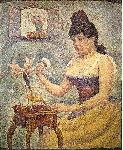
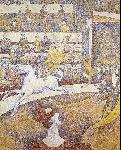












|











